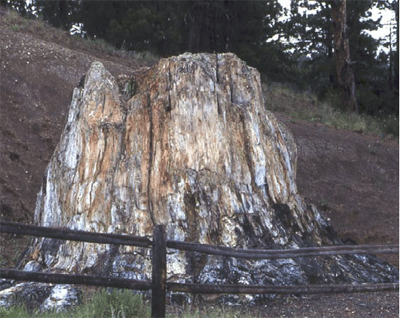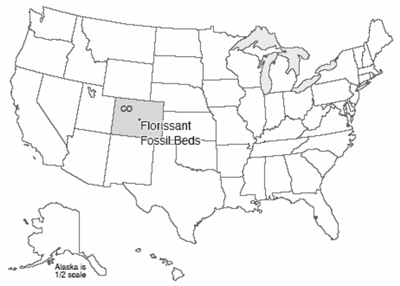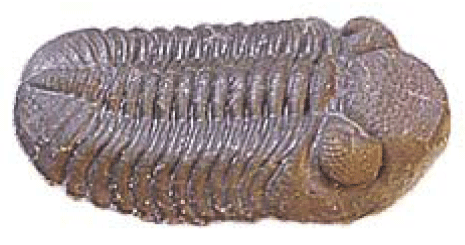Evolution and the Florissant Fossil Beds

In south-central Colorado, at Florissant Fossil Beds National Monument, you can visit a unique deposit of fossil trees, leaves, insects, birds, fish and more from about 35 million years ago. At that time, a lava flow dammed a stream to form a lake. Then, repeated volcanic eruptions dropped ash into the lake, making it silica-rich and favoring growth of diatoms, which have silica shells. Huge numbers of diatoms quickly grew in very thin layers on things that fell into the lake, protecting them from decay until they were buried by paper-thin layers of ash and mud. Like flowers pressed in a phone book, the flowers of that ancient time can still be seen clearly. So can the dragonflies, and bees, and mosquitoes. Before the National Monument was established, private collectors could pay a small fee and hunt for fossils there. The author found a few fossil bees and ants and seeds, and a friend found a beautiful cicada. (Taking fossils from the National Monument is strictly forbidden; they belong to all of us!)
There are, however, certain differences between some of those creatures and similar ones that live today. Remember, back at Arches, we learned about the law of faunal succession—when rocks are placed in order from oldest to youngest, the types of fossils in the rocks also fall into order, becoming more like things alive today in younger and younger rocks. The Florissant rocks are relatively young, and their fossils are immediately familiar to modern people, but the fossils are not identical to modern species.

The law of faunal succession suggests the possibility of evolution, but does not prove it by any means. One early theory held that many creations and extinctions occurred over geologic history, something like the history of automobiles. One type of automobile does not give birth to another; new ones are created. But you can place the automobiles in order from oldest to youngest, and the younger they are, the more they look like modern automobiles. This idea was called catastrophism in geology. The fundamentalist interpretation of biblical creation is a one-event form of catastrophism.
Evidence of Evolution
Catastrophism eventually lost out scientifically to evolution. Evolution does a much better job of explaining the patterns of fossils and of living things, and of predicting events such as the emergence of antibiotic-resistant microorganisms. The triumph of evolution over catastrophism owes much to biology, and more recently to genetics and molecular biology; the identification of the mechanisms driving evolution was especially important (see below).
As geologists collected more data, they also realized that evolution explained the data and predicted the next discoveries better than did any catastrophist model. The early geologists could see the clear march of types over time, but saw catastrophic elements in the record as well. In many places, geologists would find fossils of one type, and then of a somewhat different type, with no transitions between them. Evolution implies rather gradual change, not big jumps. The early geologists knew, however, that there were big time jumps in the records (remember all of the unconformities—time gaps—in the Grand Canyon sequence). So some of the jumps in the fossil record were related to the incompleteness of the rock record. Other jumps really are related to catastrophic events in the record (again, see below).
Further study has shown that many of the evolutionary changes have been geologically fast (but recall that geological time is so long that this can be biologically slow!) and often localized. Suppose that a few animals of some type colonize a small island. Then, they have babies who have babies who have babies, a generation per year, thousands of generations in a geological eyeblink. If the babies differ by just a tiny bit from the parents, eventually a new type or species may emerge. If that species then succeeds in escaping the island (say, because sea-level fell and the island became connected to the mainland), a new type would appear suddenly on the continent. Sediments from the small island may end up being subducted or otherwise destroyed, but fossils on the larger continent are more likely to be preserved. A small island may support only a few individuals, so there never would be many critters to produce fossils that humans could find. On the continent, the species might flourish and produce millions of individuals that would leave easily collected fossils. Thus, the fossil record would show a sudden jump when the actual process was gradual.

In one famous case (of many), trilobites of the genus Phacops are classified in part by the number of columns of elements in their compound eyes. In marine sediments from the Devonian (the middle of the Paleozoic) of Pennsylvania and Ohio, a species with eighteen columns in its eyes occurs for a while. Then, a time gap or unconformity occurs, from a temporary drying of the sea. When the sea returned and began depositing sediments again, the trilobites that returned with it had seventeen columns in their eyes. Not a huge jump, but an apparently sudden one. But wait—over in a small part of New York, the sea did not dry up. There, you can find the old eighteen-column trilobites, then some with seventeen columns plus a partial column containing a varying number of elements, and finally the seventeen-column trilobites. The generations of trilobites changed gradually, and you can see this where the rock record is complete in a small region of New York. In the bigger areas, the record looks more catastrophic because the seaway was dry and no fossils were produced when the changes were occurring through the generations living in New York.

Some so-called “creation scientists” still argue that no transitional forms are known, and so that catastrophism is accurate. This is nonsense; extremely fine gradations are known in many, many lineages. There is one technical sense in which, in some lineages for which fossils are scarce, there are missing transitional types. Suppose you find young fossil type 1 and old fossil type 0. They differ a good bit—you are missing the transitional form 1/2. Now suppose you find type 1/2. It is your “missing link”. You publish your results in important scientific journals, and wait for the fame and fortune to roll in. (You are likely to wait a looooooong time….) But, while you’re enjoying your discovery, someone argues that you are haven’t really found the missing link, because now there are TWO transitional types missing: 1/4 between 0 and your newly discovered 1/2, and 3/4 between your newly discovered 1/2 and 1. So, you go back to work, and after years of effort, succeed in finding both 1/4 and 3/4. Wow! Now your critics point out that you are missing FOUR transitional forms (1/8, 3/8, 5/8 and 7/8). This can be argued to absurdity; we cannot find remains of every creature that ever lived, because almost all remains of almost all creatures are recycled by the efficient ecosystems of Earth (dead things are food to scavengers, worms, bacteria, fungi, etc.). But in many, many lines now, the gaps are vanishingly small, and the transitional forms very well known.
The gaps in evolutionary lineages are especially well-filled for commonly fossilized types, such as shelly marine creatures from shallow water. Shells are hard and resistant—they’re really rocks already—and so shells are preserved well. Although sediments from deep-water sites tend to be dragged down subduction zones and melted, which messes up old records, the underwater edges of continents are not subducted and often escape obduction for a long while, preserving their records of shelly creatures. And while most of land is eroding, most of the ocean is accumulating sediments.
The fact that most of the land surface is eroding complicates study of the fossils that especially interest people. Think about central Pennsylvania for a moment, where Dr. Alley was sitting when he wrote this. The Commonwealth of Pennsylvania has about 1 million deer, and each buck has two antlers, so Pennsylvania deer drop about 1 million antlers per year. If antlers were “preserved,” then after even a few millennia of this, walking in the state should be really dangerous, and we should hear about all sorts of antler puncture wounds from the billions of antlers scattered over the landscape. Of course, we don’t—mice and porcupines eat the antlers for the minerals in them.
In central Pennsylvania now, the only places you can find sediments being deposited are in the reservoirs (which were mostly built in the 1930s, and so give very, very short records), a very few marshes such as Bear Meadows up the road from Penn State's University Park campus (this marsh formed during the Ice Age and thus is geologically very young), and in a few caves and along a few streams. But, the caves and stream deposits don’t last long—the caves are lost as the surface is lowered, and the streams sweep across their flood plains and move the sediments on. So central Pennsylvania today is not making much of a fossil record.
Despite difficulties such as this, careful study around the world has filled in many of the details of the fossil record, including many “missing links.” (In 2001, for example, road-builders accidentally discovered Riverbluff Cave in Missouri, with loads of ice-age fossils that are offering a new window on that interesting time.) For some types of creatures, such as hominids, fossils are still scarce enough that a new find often makes headlines, and may cause a small change in the prevailing view of evolutionary history. And there was lots of excitement in 2008 when fossils of transitional flatfish were found—Darwin had worried about the way flounders evolved so the adults have both eyes on the same side of their heads, so the discovery of the transitional forms was another in the long string of successes for the theory he advanced. However, you almost never read about the great changes in thinking caused by the latest snail fossil—the record is so wonderfully complete that new insights are much harder to come by than they used to be.
The Theory of Evolution
The basis of evolution is diversity. (Modern social scientists and politicians are about 4 billion years behind nature on this one.) We know that kids do not look exactly like their parents—offspring are diverse or different. We also know that kids share more characteristics with their parents than with less-closely-related people from the parent’s generation. That is, we look a lot like our parents, but we are not exact copies. This arises because of genetics; the biological instructions or programs that guide development of an individual are passed down from the parents, but there are many mechanisms active that serve to experiment a little with the instructions between generations.
Suppose that one of these small experiments is successful (say, it gives a young giraffe a longer neck than her neighbors, which allows her to reach leaves that are out of reach of other giraffes). The long-necked giraffe will be better-fed than others, and eventually is likely to succeed in surviving to have babies of her own. Some of those babies will grow a little taller than their mother, some a little shorter, and some the same height as their mother, but the offspring will average taller than the kids of other giraffes lacking the initial, successful change.
Those other giraffes lacking this new development will be less successful, and so will leave fewer babies who go on to have babies. Most populations are small enough that, if one individual is even slightly more successful than others, after a few thousand generations, all the survivors will be related to the one with the successful experiment; if one individual is even slightly less successful than others, after a few thousand generations it will have no survivors. (You can demonstrate this easily using mathematical models, or with greater difficulty by breeding living types such as fruit flies, but both reach the same answer.)
Once all of the members of a species contain the successful experiment, the species has been changed a little. But over those thousands of generations, other “experiments” are conducted, some successful and some not. The slow accumulation of the successful experiments is evolution. The mechanism by which the changes accumulate is called natural selection—beneficial experiments allow more survival and reproduction and so are preserved and multiplied. When enough changes have accumulated, we say that a new type or species has emerged. (If a population is split into two or more parts, those parts are called new species when they no longer can interbreed.)
Notice that things that happen to adults, such as having their ears pierced or their behinds tattooed or stretching their necks to reach leaves, are not passed on to children. The changes that are passed on occur during reproduction. Sex helps generate new combinations of genetic instructions. Even species that reproduce asexually by splitting in half have ways (proto-sex?) to exchange genetic material. Sometimes, accidents occur owing to radioactive decay or toxic chemicals damaging the genetic instructions in an egg or sperm or asexually reproducing creature; however, these often are changes that hurt rather than help.
More importantly, the mechanisms of reproduction do experiment a little by moving a few things around in the genetic instructions during reproduction. Some species, and some individuals of species, conduct more experiments than others. Overuse and misuse of antibiotics by humans are producing antibiotic-resistant disease-causing organisms. These antibiotic-resistant types are often those that experiment a lot during reproduction, and so were lucky enough to quickly find an experiment that allows survival despite antibiotics.
The virus that causes AIDS is especially hard to “beat” with a vaccine or antiviral drug because the virus experiments a huge amount. This is costly to the virus—many of the experiments are failures, which means those offspring don’t succeed. But, this high rate of experimentation allows the virus to respond quickly to challenges such as new drugs or vaccines by producing offspring with new ways to defeat those drugs or vaccines. In an AIDS patient, the virus infecting the spleen often differs from the virus infecting the liver—the virus has evolved in the person to succeed in the chemically different environments of the different organs. And, given that the AIDS viruses in just one person are so diverse, it is not surprising that the viruses in different people are different. The remarkable advances in molecular biology allow these changes to be measured now.
Evolution is a well-tested, well-established scientific theory. It makes predictions that are borne out. Partial speciation has been achieved in the laboratory in fast-breeding types such as fruit flies. The geological evidence of gradual changes is strong, and becoming steadily stronger as more and more samples are collected.
Evolution is also being used routinely in science. A search on the ISI “Web of Science” in July of 2012 revealed over 3000 scientific papers with the subject "evolution and antibiotic resistance," with an ongoing rise in the number of papers on the topic. A quick perusal of the titles and abstracts of many of those papers revealed that, as microbes evolve to defeat our antibiotics, the scientists who are trying to keep us alive are using the tools and language of evolutionary biology. Antibiotics are quickly losing effectiveness against evolving microbes, more and more people are dying of infections picked up in hospitals, and scientists are increasingly focusing on the problem, informed by a full understanding of evolution, its rates and processes.
Computer scientists even use evolution—some “artificial-intelligence” approaches have been patterned after the natural processes of evolution. Techniques such as genetic algorithms or evolutionary computation successfully solve complex problems, in essentially the same way that nature does. (For more on this, see the Unit 11 Enrichment.)
In the U.S., some groups continue to oppose evolution based primarily on religious grounds. This opposition has the good effect of keeping the experts “on their toes”—the experts work harder and do better science. This opposition has the unfortunate effect of convincing many people that something is fundamentally wrong with evolutionary theory: again, perhaps figuring that “where there’s smoke, there’s fire.” Many people believe, for example, that evolution is somehow anti-religious, when the majority of church members in the U.S. belong to denominations that endorse evolution as the best description of how the biological world works. Evolution is consistent with the major religions on Earth, and even with rather strict readings of the Christian Bible. The idea that the Earth appears young, and was created recently with all of the modern types of organisms present, was tested in the 1700s and 1800s and proved wrong.
A longer discussion of some issues—evolution and religion, second law of thermodynamics, intelligent design, etc.—is given in the Enrichment. We strongly suggest that if you are interested in this topic, you read the Unit 11 Enrichment.